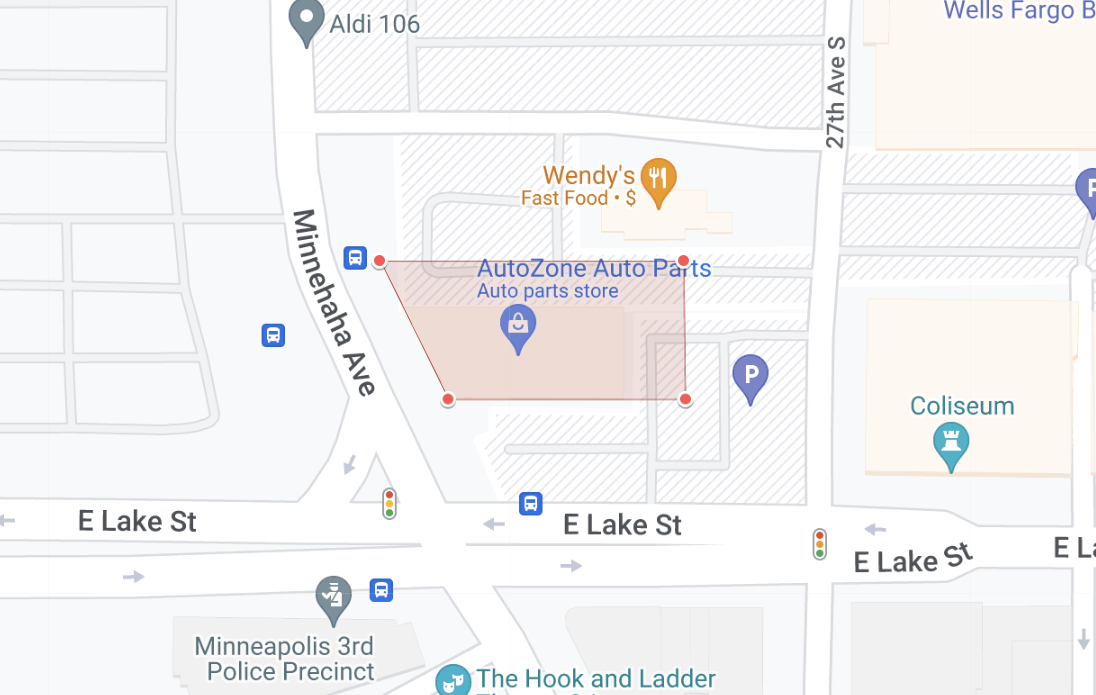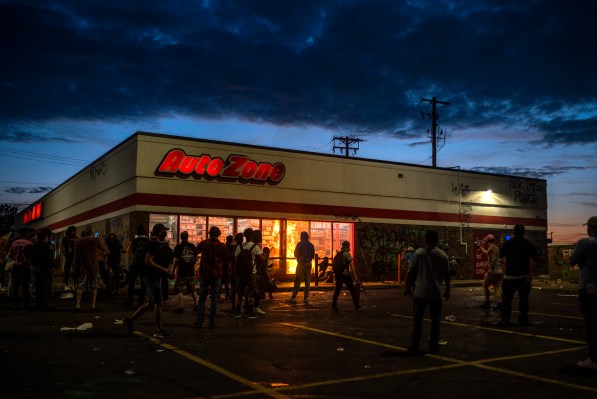Police in Minneapolis obtained a search warrant ordering Google to turn over sets of account data on vandals accused of sparking violence in the wake of the police killing of George Floyd last year, TechCrunch has learned.
The death of Floyd, a Black man killed by a white police officer in May 2020, prompted thousands to peacefully protest across the city. But violence soon erupted, which police say began with a masked man seen in a viral video with an umbrella and smashing windows of an auto-parts store in south Minneapolis. The AutoZone store was the first among dozens of buildings across the city set on fire in the days following.
The search warrant compelled Google to provide police with the account data on anyone who was “within the geographical region” of the AutoZone store when the violence began on May 27, two days after Floyd’s death.
These so-called geofence warrants — or reverse-location warrants — are frequently directed at Google in large part because the search and advertising giant collects and stores vast databases of geolocation data on billions of account holders who have “location history” turned on. Geofence warrants allow police to cast a digital dragnet over a crime scene and ask tech companies for records on anyone who entered a geographic area at a particular time. But critics say these warrants are unconstitutional as they also gather the account information on innocent passers-by.
TechCrunch learned of the search warrant from Minneapolis resident Said Abdullahi, who received an email from Google stating that his account information was subject to the warrant, and would be given to the police.
But Abdullahi said he had no part in the violence and was only in the area to video the protests when the violence began at the AutoZone store.

The warrant said police sought “anonymized” account data from Google on any phone or device that was close to the AutoZone store and the parking lot between 5:20pm and 5:40pm (CST) on May 27, where dozens of the people in the area had gathered.
When reached, Minneapolis police spokesperson John Elder, citing an ongoing investigation, would not answer specific questions about the warrant, including for what reason the warrant was issued.
According to a police affidavit, police said the protests had been relatively peaceful until the afternoon of May 27, when a masked umbrella-wielding man began smashing the windows of the AutoZone store, located across the street from a Minneapolis police precinct where hundreds of protesters had gathered. Several videos show protesters confronting the masked man.
Police said they spent significant resources on trying to identify the so-called “Umbrella Man,” who they say was the catalyst for widespread violence across the city.
“This was the first fire that set off a string of fires and looting throughout the precinct and the rest of the city,” the affidavit read. At least two people were killed in the unrest. (Erika Christensen, a Minneapolis police investigator who filed the affidavit, was not made available for an interview.)
Police accuse the Umbrella Man of creating an “atmosphere of hostility and tension” whose sole aim was to “incite violence.” (TechCrunch is not linking to the affidavit as the police would not say if the suspect had been charged with a crime.) The affidavit also links the suspect to a white supremacist group called the Aryan Cowboys, and to an incident weeks later where a Muslim woman was harassed.
Multiple videos of the protests around the time listed on the warrant appear to line up with the window-smashing incident. Other videos of the scene at the time of the warrant show hundreds of other people in the vicinity. Police were positioned on rooftops and used tear gas and rubber bullets to control the crowds.
Law enforcement across the U.S. are increasingly relying on geofence warrants to solve crimes where a suspect is not known. Police have defended the use of these warrants because they can help identify potential suspects who entered a certain geographic region where a crime was committed. The warrants typically ask for “anonymized information,” but allow police to go back and narrow their requests on potential suspects of interest.
When allowed by law, Google notifies account holders of when law enforcement demands access to the user’s data. According to a court filing in 2019, Google said the number of geofence warrants it received went up by 1,500% between 2017 and 2018, and more than 500% between 2018 and 2019, but has yet to provide a specific number of warrants
Google reportedly received over 180 geofence warrants in a single week in 2019. When asked about more recent figures, a Google spokesperson declined to comment on the record.
Read more on TechCrunch
Civil liberties groups have criticized the use of dragnet search warrants. The American Civil Liberties Union said that geofence warrants “circumvent constitutional checks on police surveillance.” One district court in Virginia said geofence warrants violated the constitution because the majority of individuals whose data is collected will have “nothing whatsoever” to do with the crimes under investigation.
Reports in the past year have implicated people whose only connection to a crime is simply being nearby.
NBC News reported the case of one Gainesville, Fla. resident, who was told by Google that his account information would be given to police investigating a burglary. But the resident was able to prove that he had no connection to the burglary, thanks to an app on his phone that tracked his activity.
In 2019, Google gave federal agents investigating several arson attacks in Milwaukee, Wis. close to 1,500 user records in response to geofence warrant, thought to be one of the largest grabs of account data to date.
But lawmakers are beginning to push back. New York state lawmakers introduced a bill last year that would, if passed, ban geofence warrants across the state, citing the risk of police targeting protesters. Rep. Kelly Armstrong (R-ND) grilled Google chief executive Sundar Pichai at a House Judiciary subcommittee hearing last year. “People would be terrified to know that law enforcement could grab general warrants and get everyone’s information everywhere,” said Armstrong.
Abdullahi told TechCrunch that he had several videos documenting the protests on the day and that he has retained a lawyer to try to prevent Google from giving his account information to Minneapolis police.
“Police assumed everybody in that area that day is guilty,” he said. “If one person did something criminal, [the police] should not go after the whole block of people,” he said.
Send tips securely over Signal and WhatsApp to +1 646-755-8849. You can also send files or documents with SecureDrop.
